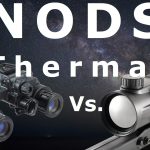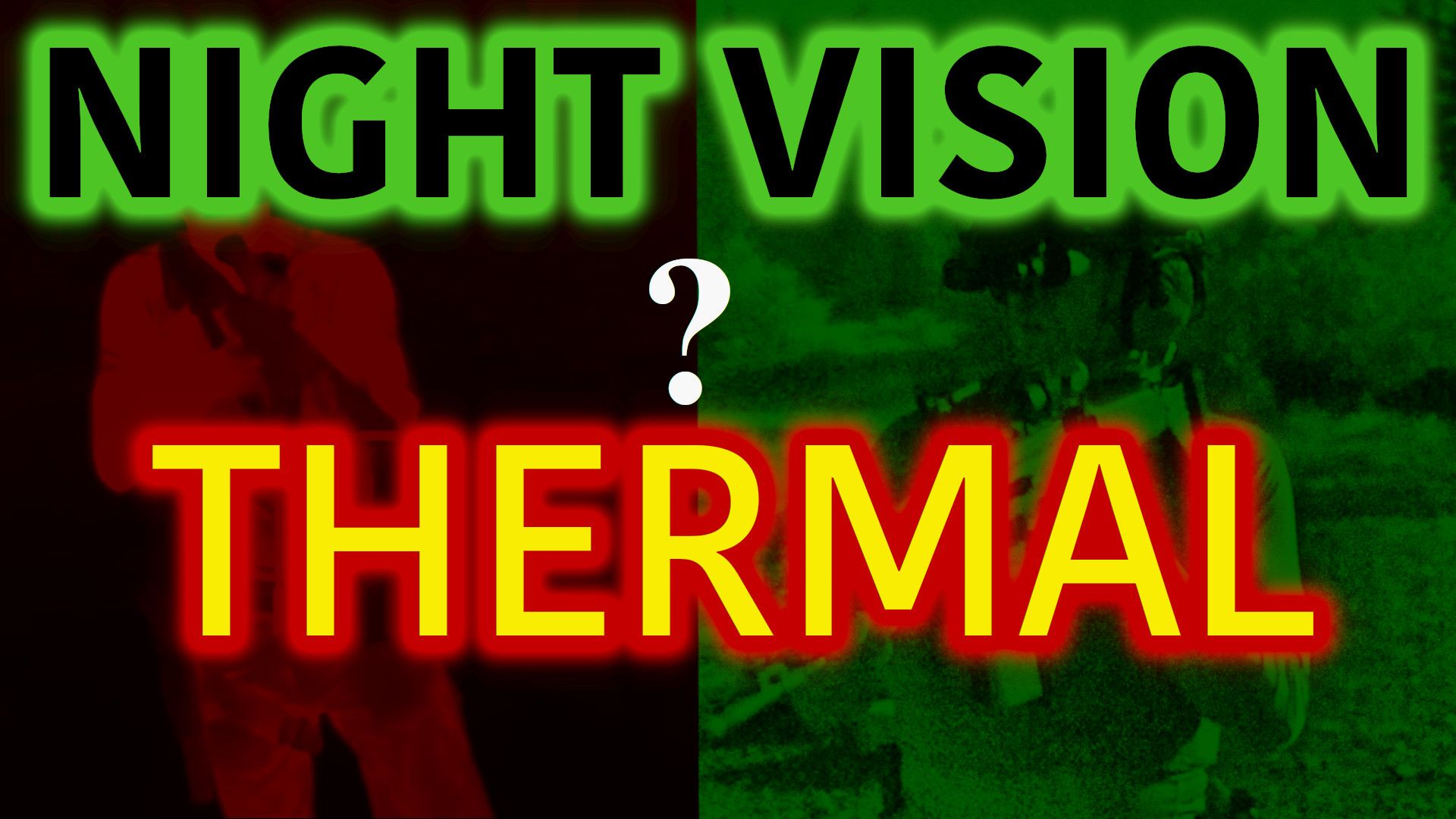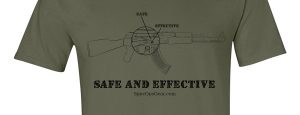When it coms to low light, there’s rarely a perfect answer; only a series of compromises. Sometimes the compromises are about money and availability, but these compromises are also about limitations of certain families of technology. What’s right for you will vary based on your needs, budget and the exact scenario that arises.
What you think will be perfect for you may turn out to have unanticipated drawbacks in the imperfect “real world” that you’re presented with. In the first part of this series, I’ll be making the argument for why thermal is a better place to start on your journey to own the night. In the next video, I’ll make a case for why night vision is the way to go. If this series gains a lot of traction, we’ll then consider how to integrate both night vision and thermal devices into comprehensive defensive systems, all for airsoft LARPing in the basement of course.
High quality thermal imaging devices can sense microscopic temperature differences, even from a long ways off. Using the right thermal scope, these devices are so sensitive that you could pick out a person’s handprint or footprint at an impressive distance away. With night vision, potential threats can easily hide and camouflage themselves from you past 40 or 50 yards away depending on how dark it is. But, those same targets stand out clear as day under thermal imaging at extended ranges.
You will not fear the terror of night…
nor the pestilence that stalks in the darkness…
A thousand may fall at your side,
ten thousand at your right hand,
but it will not come near you.
Psalm 91:5-7
Is Thermal Better Than Night Vision?

While night vision is more well-known, in this first video I’m going to make my case for why thermal might be a better place to start your low light journey. The next video in this series will explain the advantages of night vision. Let’s begin, you can get an effective thermal low light setup going for cheaper than a real night vision setup. An entry level PVS-14 costs between $2,500-$3,500 at the time of this writing. Unlike most computers and electronics, analog night vision devices are getting more expensive as time goes on, not cheaper. In contrast, thermal imaging devices are getting better and the devices are getting a bit more affordable.
Adding further savings to a thermal rifle scope: thermal scopes don’t necessitate a bunch of other gear like night vision does. Shooting with NVG requires a NODs compatible optic, a laser aiming module along with a helmet and mounting system. These necessary night vision accessories add between $1,000-$2,000 to the total cost of effectively fielding a rifle and head-mounted night vision. In total, a basic (one eye only) PVS-14 and fighting loadout can easily cost $4,000-$5,000 not counting the cost of a rifle and plates. Sure, you can cobble together a low cost digital night vision setup by using a Sightmark Wraith or Sionyx Aurora action camera. But, I don’t see anyone giving up their intensifier tubes for Auroras.
In contrast, you can get an effective thermal rifle scope like the AGM Rattler TS-25 384 core for less than 2 grand on LimitlessAmerica.com right now. FYI, if you call in and tell “Eric” that Spec Ops Gear sent you, they might be able to… work with you. Of course, there’s many cheaper thermal optics out there, but for the use case of prepared citizen I’d consider the 384 core AGM Rattler to be a decent minimum quality to consider. AGM’s TS-25 384 core is effective out to about 150 yards and comes with an American Defense quick detach mount from the factory. For 2 grand even, the AGM can effectively be used as a handheld monocular to look, scan and address targets as the need arises; all for about half the cost of a budget-tier PVS14, laser and helmet mount.
Unlike night vision, thermal imaging doesn’t need starlight or moonlight to function. It can literally be pitch black outside with no visible moon and no stars and a thermal scope will still be able to function at 100% capacity. Let’s get out into the real world and look at some examples. Guys who go out and shoot things in the dark nearly every night universally prefer thermal optics over night vision devices. Ranchers and farmers in Texas hunt hogs and coyotes to protect their crops and livestock because their way of life depends on successfully putting down harmful pests nightly. For this, thermal is king. In the ranchlands of Texas and the midwest, higher end thermal scopes like the iRay RICO series and the Pulsar Thermion have become famous for allowing ranchers to make surgical strikes out to 400 and even 500 yards. For what it’s worth, LimitlessAmerica.com can get you a high end InfiRay RICO for about the same as a midpriced PVS-14 and Laser setup.
Offense Vs Defense
Thermal imaging’s long detection range and the ease with which it can be rifle mounted for accurate shots in pitch black environments make it ideal for defensive use. While head-mounted night vision like DTNVS or the PVS31 have been made famous from their use in clandestine and spec ops offensive raids, night vision has a very short detection range compared to thermal. Let’s run a hypothetical scenario for a moment. Suppose milsim LARPer A is tasked with attacking LARPer B at night. Let’s arm attacking LARPer A with a gen 3 dual tube setup valued at $8,000 before any accessories like lasers or IR illuminators. But, let’s arm the defender, LARPer B, with a budget tier AGM Rattler 384 core scope valued at $2,000. All else being equal, the defender armed with the thermal optic will be able to detect and engage their opponent from much further away.
Thermal Resolution
Let’s talk about thermal resolution for a moment. Most of us first saw thermal imaging on the movie Predator or video games like Call Of Duty if you’re younger. But while pop culture tends to over-state what night vision can do, it often underestimates thermal. Note, when I talk about thermal resolution, I’m talking about the thermal sensor resolution, not the display screen. Cheap thermal handheld devices and poverty-tier rifle scopes have sensors below the 300×200 line. If your budget is really limited, a cheap handheld thermal can get you a lot of low light capability for as little as $500 bucks. But, to truly be effective and get into modern thermal technology, the current minimum price is around 2 grand with a minimum sensor resolution of around 384 core.
384 core is my minimum qualification for what I call budget thermal devices while 640 core is my current Gold Standard for thermal scopes.
Battery Life
One of the criticisms of thermal imaging devices is their short battery life. However, modern devices like the AGM Rattler and the iRay RH50 allow for the use of remote mounted USB batteries. In a grid-down scenario, it would be fairly simple to rotate out solar charged external USB power banks in order to sustain nightly thermal patrols. On the AGM Rattler, I’d use these convenient magnetic breakaway adapters and stow the battery bank in a stock-mounted pouch or just tape it onto the rifle in a pinch. For the iRay MK1 and Alpha style rifle scopes, the removable and rechargeable batteries last me multiple nights and are easily recharged using USB solar as well. In this way, so long as you had plenty of rechargeable external battery packs, you’d be able to sustain your night fighting patrols for an extended period of “unpleasantness.”
Thermal: Best Use Case
Thermal is the top dog for low light hunting, passive observation and detecting warm-blooded creatures at extended ranges. For low light perimeter defense, even a budget-tier 384 core thermal device will detect threats much further off than even a top tier night vision device. Night vision scopes require bright infrared illuminators to see details at distance; thermal just requires batteries. Texas hog hunters almost exclusively use thermal monoculars and thermal rifle scopes to defend their crops from almost nightly raids from crafty animals who are very determined. If you ever ended up in a position where you needed to defend your family from night attacks, it seems reasonable that your number 1 choice for early detection, extended range and cost effectiveness would always be some type of thermal imaging device.


